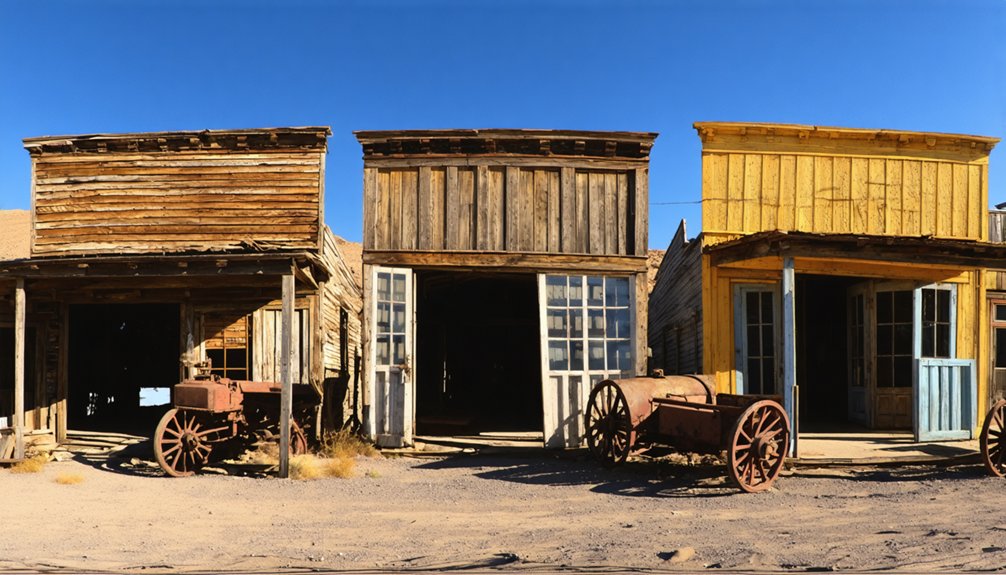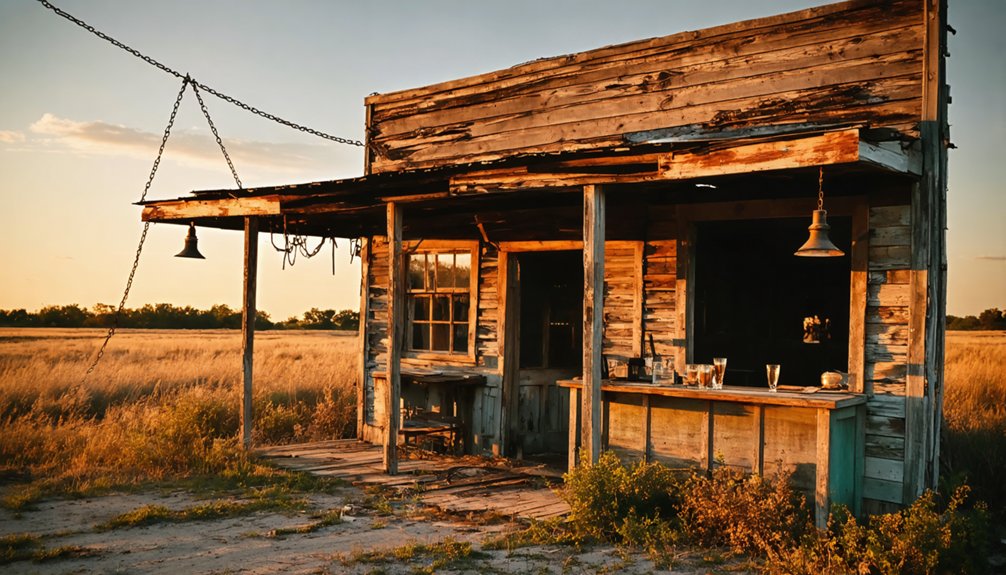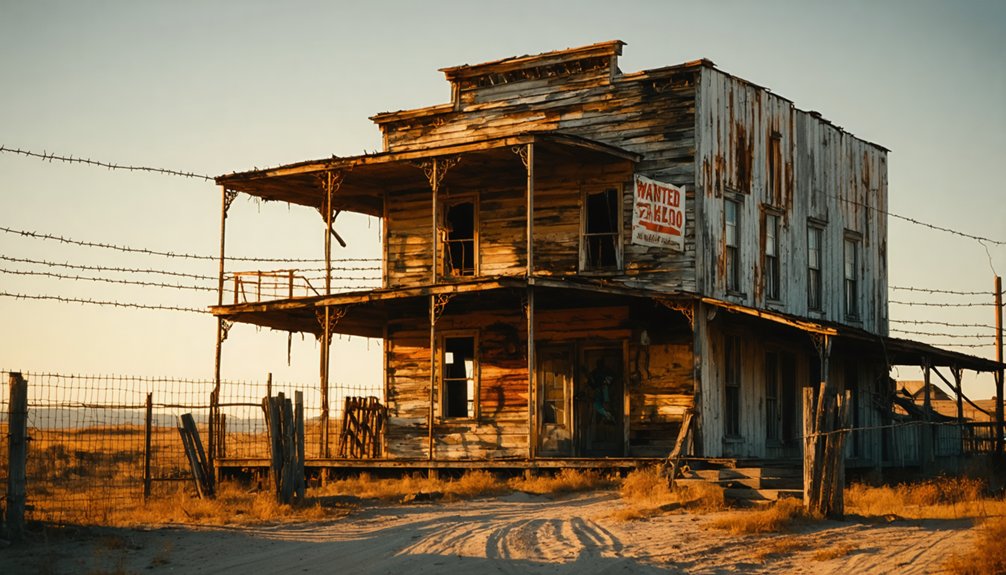Nevada’s forgotten gold rush towns include Rhyolite, Belmont, and Eldorado Canyon. In Rhyolite, you’ll find Tom Kelly’s remarkable Bottle House constructed from 51,000 recycled glass bottles. Belmont thrived with $15 million in silver ore production before its inevitable decline. Eldorado Canyon, Nevada’s oldest mining district, gained notoriety for its lawlessness and the productive Techatticup Mine. These abandoned settlements offer fascinating glimpses into the boom-and-bust cycles that defined the state’s mining heritage.
Key Takeaways
- Rhyolite thrived after a 1904 gold discovery, reaching up to 10,000 residents before rapid decline by 1911.
- Belmont boomed following 1865 silver strikes, producing $15 million in ore before eventual abandonment.
- Eldorado Canyon, Nevada’s oldest mining district, operated the productive Techatticup Mine beginning in 1863.
- Rhyolite featured modern amenities like electrical lines, while preserving Tom Kelly’s unique 51,000-bottle house.
- These ghost towns exemplify Nevada’s boom-and-bust mining cycle, now attracting history enthusiasts and tourists.
Rhyolite: The Bottle House Ghost Town
Nestled among the Bullfrog Hills of Nevada, Rhyolite emerged as one of the most promising mining settlements during the early 20th century gold rush. Following Shorty Harris and Ernest Cross’s 1904 discovery, this boomtown quickly developed into the “Queen City” of the Death Valley mining region, reaching a peak population of 5,000-10,000 by 1908.
Rhyolite history showcases the ephemeral nature of mining communities—from rapid development to abandonment in just over a decade. The town’s distinctive Rhyolite architecture is exemplified by Tom Kelly’s Bottle House, constructed from 51,000 recycled glass bottles. The surrounding landscape features abundant light-colored igneous rock formed from silica-rich magma that gave the town its geological name.
Despite its advanced amenities—electrical lines, railroad depot, banks, and an opera house—the depletion of gold mines by 1911 and the Financial Panic of 1907 precipitated its decline. The town’s commercial district once boasted an impressive 18 grocery stores and 50 saloons during its heyday. By 1920, only 24 inhabitants remained, leaving behind the ruins you can explore today.
Belmont: Silver Strikes and Legendary Visitors
While the famous mining town of Rhyolite captured headlines to the south, Belmont emerged as one of Nevada’s most significant silver boomtowns following discoveries in 1865 within the Silver Bend district.
The remarkable high-grade silver veins, yielding up to $3,000 per ton, attracted thousands of miners, swelling the population to approximately 2,000 residents by the 1870s.
You’ll find Belmont’s history marked by economic prosperity and social turbulence. The mining infrastructure—mills, shafts, and processing facilities—fueled the town’s $15 million ore production. Despite a brief decline in 1868-1869, the town experienced another economic boom by 1873.
A violent riot in April 1867 exposed tensions between workers and management over hiring practices, particularly favoring Cornish miners.
The once-thriving community boasted brick buildings, newspapers, and saloons. Colonel Buell’s Mill played a crucial role in the town’s success, extracting $100,000 in silver bullion from local ore.
Today, the well-preserved courthouse stands as a reflection of Belmont’s silver legacy, now a near-ghost town attracting history enthusiasts.
Eldorado Canyon: Nevada’s Oldest Mining District
Beyond Belmont’s silver boom lies Eldorado Canyon, which predates many of Nevada’s famous gold and silver rushes as the state’s oldest mining district.
First prospected around 1857, the area quickly attracted miners seeking fortune from its rich gold mining veins, particularly the Salvage Vein discovered in 1861.
The Techatticup Mine, opening in 1863, became the canyon’s most productive operation, with tunnels extending 500 feet below ground. The mine was established by the Southwest Mining Company along with other early operations in the area. The discovery of the Comstock Lode in 1859 drew some miners away, but Eldorado Canyon maintained significant operations during the silver mining boom.
You’ll find evidence of innovative processing methods, from the first ten-stamp mill to later cyanide operations that increased extraction efficiency.
Eldorado’s lawlessness legacy is legendary—Civil War deserters, claim-jumpers, and outlaws created a violent atmosphere where gunfights were common and murder investigations often abandoned.
This isolation, coupled with disputed mine ownership, fostered a freedom-seeking yet dangerous society that defined Nevada’s early mining culture.
Frequently Asked Questions
How Did Highgrading Practices Impact Goldfield’s Gold Production Statistics?
With miners pocketing up to an ounce per ton, highgrading effects substantially lowered official production statistics. You’ll find reported yields were artificially diminished as significant quantities of rich ore circulated unofficially through town.
What Caused Tonopah’s Mining Operations to Continue Longer Than Neighboring Boom Towns?
Tonopah’s longevity stemmed from diversified silver-gold operations, advanced mining technology, established infrastructure, and adaptive leasing systems that allowed exploitation of deeper, more complex ore bodies than surrounding single-metal towns.
Why Did Goodsprings Mine Diverse Minerals Instead of Focusing on Gold?
Geologically diverse, economically strategic, you’ll find Goodsprings’ success stemmed from carbonate replacement deposits hosting multiple metals. Their infrastructure investments and wartime market demands made mineral diversity more profitable than gold-exclusive mining.
Were There Any Significant Indigenous Conflicts During Nevada’s Mining Boom?
You’ll find the Pyramid Lake War of 1860 represents the most significant indigenous resistance against Nevada’s mining expansion, with Paiute tribes fighting against encroachment on their traditional lands and resources.
How Did Transportation Networks Influence Which Mining Towns Survived?
You’ll find that towns with railroad connections thrived through efficient mining logistics, while isolated settlements perished. Railroad expansion transformed struggling camps into sustainable communities by enabling economic diversification beyond mineral extraction.
References
- https://findingnevadawild.com/goldfield-the-old-west-lives-in-nevadas-best-ghost-town/
- https://shpo.nv.gov/uploads/documents/Historic_Marker_Booklet_Online_Version_with_Links_2022_Final.pdf
- https://travelthruhistory.com/reviving-the-past-exploring-the-ghost-towns-of-nevada/
- https://ronhess.info/docs/report7_history.pdf
- https://www.youtube.com/watch?v=hiJQZT6jL3Y
- http://nyecountyhistory.com/tonopah_berg/tonopah.pdf
- https://savingplaces.org/stories/explore-wild-west-mining-history-in-nevada-ghost-towns
- https://archive.org/stream/culturalresource00sutt/culturalresource00sutt_djvu.txt
- https://en.wikipedia.org/wiki/List_of_ghost_towns_in_Nevada
- https://now.acs.org/results/browse/default.aspx/Preserving_The_Glory_Days_Ghost_Towns_And_Mining_Camps_Of_Nye_County_Nevada.pdf



